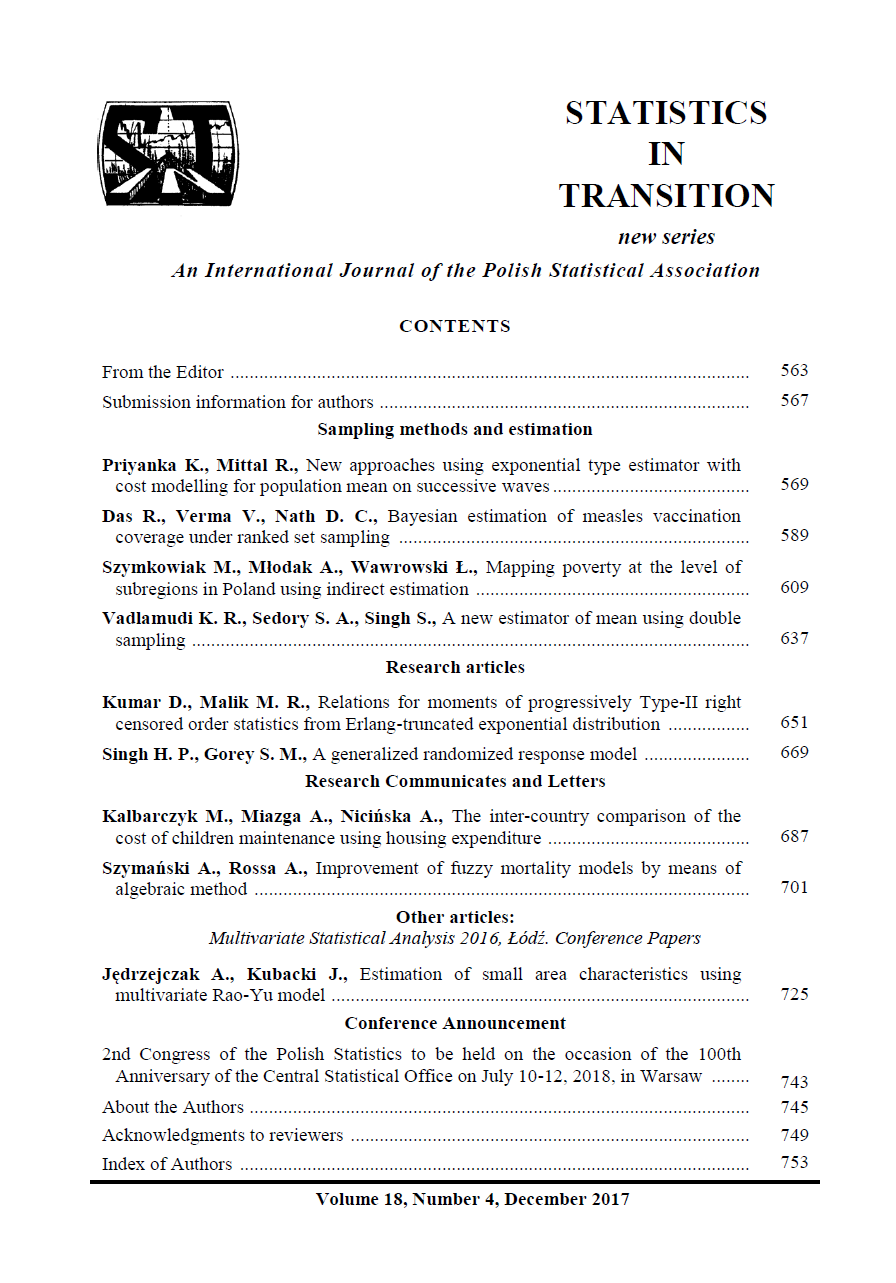ARTICLE
ABSTRACT
The growing demand for high-quality statistical data for small areas coming from both the public and private sector makes it necessary to develop appropriate estimation methods. The techniques based on small area models that combine time series and cross-sectional data allow for efficient "borrowing strength" from the entire population and they can also take into account changes over time. In this context, the EBLUP estimation based on multivariate Rao-Yu model, involving both autocorrelated random effects between areas and sampling errors, can be useful. The efficiency of this approach involves the degree of correlation between dependent variables considered in the model. In the paper we take up the subject of the estimation of incomes and expenditure in Poland by means of the multivariate Rao-Yu model based on the sample data coming from the Polish Household Budget Survey and administrative registers. In particular, the advantages and limitations of bivariate models have been discussed. The calculations were performed using the sae and sae2 packages for R-project environment. Direct estimates were performed using the WesVAR software, and the precision of the direct estimates was determined using a balanced repeated replication (BRR) method.
KEYWORDS
small area estimation, EBLUP estimator, Rao-Yu model, multivariate analysis.
REFERENCES
BENAVENT, R., MORALES, D., (2015). Multivariate Fay–Herriot models for small area estimation, Computational Statistics & Data Analysis, Vol. 94, February 2016, pp. 372–390, http://www.sciencedirect.com/science/article/pii/S016794731500170X.
DATTA, G. S., FAY, R. E., GHOSH, M., (1991). Hierarchical and empirical Bayes multivariate analysis in small area estimation. In: Proceedings of Bureau of the Census 1991 Annual Research Conference, US Bureau of the Census, Washington, DC, pp. 63–79.
DATTA, G. S., GHOSH, M., NANGIA, N., NATARAJAN, K., (1996).Estimation of median income of four-person families: a Bayesian approach. In: Berry, D. A., Chaloner, K. M., Geweke, J. M. (Eds.), Bayesian Analysis in Statistics and Econometrics. Wiley, New York, pp. 129–140.
DATTA, G. S., DAY, B. MAITI, T., (1998). Multivariate Bayesian Small Area Estimation: An Application to Survey and Satellite Data, Sankhya: The Indian Journal of Statistics, Series A (1961-2002), Vol. 60, No. 3, Bayesian Analysis (Oct., 1998), pp. 344–362,http://sankhya.isical.ac.in/search/60a3/60a3ga.html.
DIALLO, M. S., (2014). Small Area Estimation under Skew-Normal Nested Error Models, A thesis submitted to the Faculty of the Graduate and Research in partial fulfillment of the requirements for the degree of Doctor of Philosophy, Carleton University, Ottawa, Canada.
FABRIZI, E., FERRANTE, M. R., PACEI, S., (2005). Estimation of poverty indicators at sub-national level using multivariate small area models, Statistics in Transition, December 2005, Vol. 7, No. 3, pp. 587–608.
FAY, R. E., (1987). Application of multivariate regression to small domain estimation, Small Area Statistics, Eds.: R. Platek, J. N. K., Rao, C. E.,Sarndal, M. P., Singh. Wiley, New York, pp. 91–102.
FAY, R. E., DIALLO, M., (2012). Small Area Estimation Alternatives for the National Crime Victimization Survey, [in:] Proc. Survey Research Methods Section of the American Statistical Association, pp. 3742–3756, https://ww2.amstat.org/sections/SRMS/Proceedings/y2012/Files/304438_73111.pdf.
FAY, R. E, DIALLO, M., PLANTY, M., (2013). Small Area Estimates from the National Crime Victimization Survey, [in:] Proc. Survey Research Methods Section of the American Statistical Association, pp. 1544–1557, http://ww2.amstat.org/sections/srms/Proceedings/y2013/Files/308383_80758.pdf.
FAY, R. E., DIALLO, M., (2015). sae2: Small Area Estimation: Time-series Models, package version 0.1-1, https://cran.r-project.org/web/packages/sae2/index.html.
FAY, R. E., HERRIOT, R. A., (1979). Estimation of Income from Small Places: An Application of James-Stein Procedures to Census Data, Journal of the American Statistical Association, 74, pp. 269–277, http://www.jstor.org/stable/2286322.
FAY, R. E., LI, J., (2012). Rethinking the NCVS: Subnational Goals through Direct Estimation, presented at the 2012 Federal Committee on Statistical Methodology Conference, Washington, DC, Jan. 10–12, 2012,https://s3.amazonaws.com/sitesusa/wp content/uploads/sites/242/2014/05/Fay_2012FCSM_I-B.pdf.
GERSHUNSKAYA, J., (2015). Combining Time Series and Cross-sectional Data for Current Employment Statistics Estimates, Proceedings of the Joint Statistical Meetings 2015 Survey Research Methods Section, Seattle, Washington, August 8 13, 2015,http://ww2.amstat.org/sections/srms/Proceedings/y2015/files/233962.pdf.
GONZÁLEZ-MANTEIGA, W., LOMBARDÍA, M. J., MOLINA, I., MORALES, D., SANTAMARÍA, L., (2005). Analytic and bootstrap approximations of prediction errors under a multivariate Fay–Herriot model. Working Paper 05-49 (10), Statistics and Econometrics Series 061, Departamento de Estadística, Universidad Carlos III de Madrid,https://e-archivo.uc3m.es/bitstream/handle/10016/230/ws054910.pdf.
JANICKI, R., (2016). Estimation of the Difference of Small Area Parameters from Different Time Periods. Center for Statistical Research & Methodology Research Report Series (Statistics #RRS2016-01). U.S. Census Bureau,https://www.census.gov/srd/papers/pdf/RRS2016-01.pdf.
JĘDRZEJCZAK, A., KUBACKI, J., (2016). Estimation of Mean Income for Small Areas in Poland Using Rao-Yu Model, Acta Universitatis Lodziensis, Folia Oeconomica, 3 (322), pp. 37–53.
LI, J., DIALLO, M. S., FAY, R. E., (2012). Rethinking the NCVS: Small Area Approaches to Estimating Crime, presented at the Federal Committee on Statistical Methodology Conference, Washington, DC, Jan. 10–12, 2012, https://s3.amazonaws.com/sitesusa/wp content/uploads/sites/242/2014/05/Li_2012FCSM_I-B.pdf.
MOLINA, I., MARHUENDA, Y., (2015). sae: An R Package for Small Area Estimation, The R Journal, Vol. 7, No. 1, pp. 81–98, http://journal.r project.org/archive/2015-1/molina-marhuenda.pdf.
OECD, (2008). Growing Unequal? Income Distribution and Poverty in OECD Countries,http://www.oecd-ilibrary.org/social-issues-migration-health/growing unequal_9789264044197-en.
OECD, (2011). Divided We Stand: Why Inequality Keeps Rising, OECD Publishing, http://dx.doi.org/10.1787/9789264119536-en.
PORTER, A. T., HOLAN, S. H., WIKLE, C. K., (2015). Multivariate spatial hierarchical Bayesian empirical likelihood methods for small area estimation. STAT, 4, 108–116, DOI: 10.1002/sta4.81,http://onlinelibrary.wiley.com/doi/10.1002/sta4.81/abstract.
RAO, J. N. K., (2003). Small Area Estimation, Wiley Interscience, Hoboken, New Jersey.
RAO, J. N. K., MOLINA, I., (2015). Small Area Estimation (2nd edition). John Wiley & Sons, Inc., Hoboken, New Jersey.
RAO, J. N. K., YU, M., (1992). Small area estimation combining time series and cross-sectional data. Proc. Survey Research Methods Section. Amer. Statist. Assoc., pp.1–9,https://ww2.amstat.org/sections/SRMS/Proceedings/papers/1992_001.pdf.
RAO, J. N. K., YU, M., (1994). Small-Area Estimation by Combining Time Series and Cross-Sectional Data, The Canadian Journal of Statistics, Vol. 22, No. 4, pp. 511–528, http://www.jstor.org/stable/3315407.
R CORE TEAM, (2015). R: A Language and Environment for Statistical Computing, R Foundation for Statistical Computing, Vienna, Austria, http://www.R-project.org.
WESTAT, (2007). WesVar® 4.3 User’s Guide.
YU, M., (1993). Nested error regression model and small area estimation combining cress-sectional and time series data, A thesis submitted to the Faculty of the Graduate and Research in partial fulfillment of the requirements for the degree of Doctor of Philosophy, Carleton University, Ottawa, Canada.
